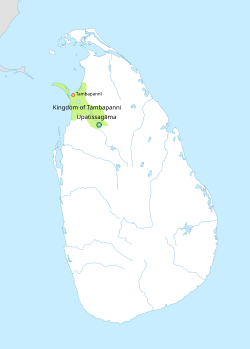Kingdom of Tambapanni
Kingdom of Tambapaṇṇī | |||||||||||
|---|---|---|---|---|---|---|---|---|---|---|---|
| 543 BC–437 BC | |||||||||||
 Kingdom of Tambapanni | |||||||||||
| Capital | Tambapaṇṇī[1] Upatissagāma[2] Vijithapura[3] | ||||||||||
| Common languages | Elu | ||||||||||
| Demonym(s) | Sinhalese | ||||||||||
| Government | Monarchy | ||||||||||
| King | |||||||||||
• 543–505 BC | Vijaya | ||||||||||
• 505–504 BC | Upatissa | ||||||||||
• 504–474 BC | Panduvasdeva | ||||||||||
• 474–454 BC | Abhaya | ||||||||||
• 454–437 BC | Tissa | ||||||||||
| Historical era | Indo-Aryan settlement | 543 BC | |||||||||
• Consecration of Vijaya | 543 BC | ||||||||||
| 458–439 BC | |||||||||||
• Kingdom moved to Anuradhapura | 437 BC | ||||||||||
| |||||||||||
| Historical states of Sri Lanka | |
|---|---|
 | |
| 1232–1620 | |
| 1521–1594 |
The Kingdom of Tambapaṇṇī (
Name
Tambapaṇṇī is a name derived from Tāmraparṇī or Tāmravarṇī (in
Background
Ancient grave sites that were used before 600
Sinhalese history and the historical period of Sri Lanka traditionally starts in 543 BC with the arrival of Prince Vijaya.[citation needed]Legend has it that when Prince Vijaya landed on the shores of the island he kissed the sand, called it 'Thambapanni' and planted a flag depicting a lion in the ground. (The famous 'Sanchi' ruins of India depict the events of Prince Vijaya'a landing).[9] After landing in Tambapaṇṇī, Vijaya met Kuveni the queen of the Yakkhas, who was disguised as a beautiful woman but was really a yakkhini named Sesapathi.[10]
History
The Kingdom of Tambapaṇṇī was founded by
Upatissagāma was the second capital of the kingdom. It was seven or eight miles further north of the previous capital Tambapaṇṇī.[3][13][14] The city was established by Upatissa, a follower and senior minister of Vijaya.
During the end of his reign Vijaya, who was having trouble choosing a successor, so sent a letter to the city of his ancestors at Sinhapura, in order to invite his brother Sumitta to take over the throne.[15] However Vijaya had died before the letter had reached its destination so the monarchy was succeeded by his chief minister Upatissa who acted as king for a year.[2]
See also
- Pre Anuradhapura period
- List of Sri Lankan monarchs
References
Citations
- ^ a b palikanon.com 2019.
- ^ a b Malalasekera 2017.
- ^ a b Codrington 1926, p. 9.
- ^ Perera n.d.
- ^ Chapter III. Connection With Ceylon, Generally One Of Hostility 2009.
- ^ Blaze 1933, p. 6.
- ^ Naizer 2009.
- ^ Manathunga 2007.
- ^ Mittal 2006, p. 405.
- ^ King Vijaya (B.C. 543-504) and his successors 2009.
- ^ Blaze 1933, p. 7.
- ^ Blaze 1933, p. 12.
Bibliography
- Blaze, L. E. (1933). History of Ceylon (PDF) (Eighth ed.). Colombo: Christian literature society for India and Africa.
- Codrington, H. W. (1926). A Short History Of Ceylon. London: Macmillan & Co.
- Senaveratna, John M. (1930). The Story of the Sinhalese from the Most Ancient Times Up to the End of "the Mahavansa" Or Great Dynasty: Vijaya to Maha Sena, B.C. 543 to A.D.302. Colombo: W. M. A. Wahid & Bros. ISBN 9788120612716.
- Mittal, J.P. (2006). "Other dynasties". History of Ancient India: From 4250 BC to 637 AD. Vol. 2 of History of Ancient India: A New Version. Atlantic Publishers & Distributors. ISBN 81-269-0616-2. Retrieved 6 November 2009.
- "Tambapanni". www.palikanon.com. Retrieved 23 February 2019.
- Manathunga, Anura (4 February 2007). "The first battle for freedom". Ths Sunday Times. Retrieved 6 November 2009.
- Naizer, Nizla (4 February 2009). "Evolution of the National Flag". The Bottom Line. Archived from the original on 22 July 2011. Retrieved 6 November 2009.
- Malalasekera, G. P. (5 February 2017). "Upatissagāma". www.softerviews.org. Dictionary of Pāli Proper Names. Archived from the original on 27 March 2019. Retrieved 23 February 2019.
- Perera, D. G. A. (n.d.). "Lankan place name in historical perspective". The island. Retrieved 25 August 2011.
- "Chapter III. Connection With Ceylon, Generally One Of Hostility". chestofbooks.com. Retrieved 6 November 2009.
- "King Vijaya (B.C. 543-504) and his successors". lankalibrary.com. Retrieved 6 November 2009.
